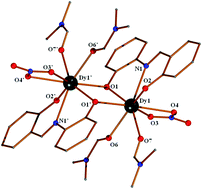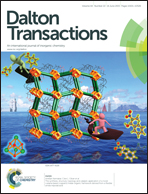A family of dinuclear lanthanide(iii) complexes from the use of a tridentate Schiff base†
Abstract
The use of N-salicylidene-o-aminophenol (H2saph) in 4f-metal chemistry has led to the isolation of seven new isostructural lanthanide(III) [LnIII] complexes. More specifically the Ln(NO3)3·xH2O/H2saph/Et3N (1 : 1 : 1) reaction mixtures in DMF/MeCN gave complexes [Ln2(NO3)2(saph)2(DMF)4] (Ln = Sm (1); Eu (2); Gd (3); Tb (4); Dy (5); Ho (6); Er (7)) in good yields (∼65%). The structures of the isomorphous complexes 3 and 5 were solved by single-crystal X-ray crystallography; the other complexes are proposed to be isostructural with 3 and 5 based on elemental analyses, IR spectra and powder XRD patterns. The two LnIII atoms in the centrosymmetric molecules of 3 and 5 are doubly bridged by the deprotonated iminophenolato oxygen atoms of two nearly planar η1:η1:η2:μ saph2− ligands. The imino nitrogen and five terminal oxygen atoms (the salicylaldiminate, two from one bidentate chelating nitrato group and two from two DMF ligands) complete square antiprismatic coordination at each metal centre. The IR spectra of the complexes are discussed in terms of the coordination modes of the ligands present in the complexes. Solid-state emission studies for all 1–7 display identical ligand-based photoluminescence. Dc magnetic susceptibility studies in the 2–300 K range reveal the presence of a weak, intramolecular antiferromagnetic exchange interaction (J = −0.19(1) cm−1 based on the spin Hamiltonian H = −J(ŜGd·ŜGd′)) for 3 and probably ferromagnetic exchange interaction within the molecules of 4 and 5. Ac magnetic susceptibility measurements in zero dc field show temperature- and frequency-dependent out-of-phase signals with two well defined, thermally-activated processes for 5, suggesting potential single-molecule magnetism character. The Ueff value is 17.4 cm−1 for the higher temperature process and 16.2 cm−1 for the lower temperature one. The combination of photoluminescence and single-molecule behaviour in the DyIII2 complex 5 is critically discussed.


 Please wait while we load your content...
Please wait while we load your content...